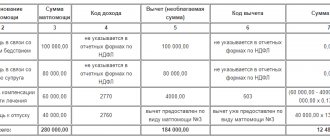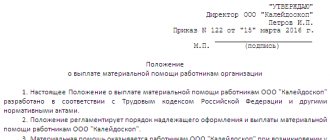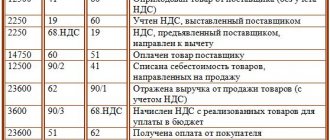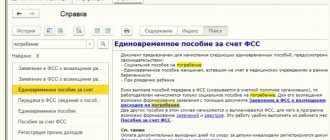Procedure for providing financial assistance
The employer makes a decision on payment and amount based on the application. The application is accompanied by documents confirming the reason for providing assistance - a child’s birth certificate, an employee’s death certificate, certificates of the family’s financial condition, and other forms. A positive decision on the application is reflected in the entry on the document and order. On the application, the manager makes a note about the amount and source of payment. The document contains information:
- Details of the person receiving financial assistance. Indicate the full name, position of the employee or passport details of the retired person.
- Link to internal document for assistance.
- Individual reason or circumstances for payment.
- Amount provided in aid.
- Date of payment for urgent reasons.
The order is sent to the accounting department to provide the basis for calculating the amount and taxes, making payments and deductions to the budget. Payment in any form is allowed - cash or non-cash transfer.
Taxation and insurance contributions for financial assistance
Financial assistance is not subject to personal income tax and insurance contributions:
- If its size does not exceed 4000 rubles.
- Assistance paid in case of personal injury due to a natural disaster
- Assistance paid for damage caused by a terrorist attack
- Assistance was paid due to the death of a close relative or the employee himself
- Assistance in the amount of up to 50,000 rubles. in connection with the birth of a child (this amount is total for both parents, each receiving payment at their place of work)
Amounts of paid financial assistance do not reduce income tax, i.e. They cannot be taken into account in expenses.
One of the most common types of financial assistance is payment in connection with vacation. It is equivalent to payment for time worked, therefore it is subject to personal income tax and contributions in full.
With a simplified taxation system, if mat. assistance is established by the regulations of the organization, it is equivalent to the payment of wages. Therefore, it can be included in expenses (tax object “Income minus expenses”). For payments under the simplified regime, the same rules apply as for the general regime, i.e. cases when swearing assistance is not subject to contributions and personal income tax is the same.
Personal income tax: two types of financial assistance
Situation: when calculating personal income tax on financial assistance paid to employees during the first year at the birth (adoption) of a child, is it possible to take into account a deduction in the amount of 4,000 rubles if the payment amount exceeds 50,000 rubles?
Answer: no, you can't.
This is due to the fact that these limits (4,000 rubles and 50,000 rubles) are established for different types of financial assistance. Financial assistance, paid during the first year at the birth of a child, is a one-time payment that is associated with a specific event. It is exempt from personal income tax in the amount of no more than 50,000 rubles. (paragraph 7, clause 8, article 217 of the Tax Code of the Russian Federation). In addition to this one-time payment, the organization can provide the employee with financial assistance for any other reason. Such financial assistance is not subject to personal income tax up to 4,000 rubles. (clause 28 of article 217 of the Tax Code of the Russian Federation). In the Tax Code, these payments are considered as different types of financial assistance. Therefore, it is impossible to simultaneously apply the rules of paragraph 7 of paragraph 8 and paragraph 28 of Article 217 of the Tax Code of the Russian Federation.
Situation: is it necessary to withhold personal income tax if an employee is given financial assistance twice during the year - in connection with the death of his mother and in connection with the death of his spouse?
Answer: no, it is not necessary.
As a general rule, the amount of one-time financial assistance to an employee in connection with the death of his family members is not subject to personal income tax (paragraph 3, paragraph 8, article 217 of the Tax Code of the Russian Federation). Financial assistance is recognized as one-time assistance if it is provided for certain purposes no more than once in a tax period on one basis. This conclusion follows, in particular, from the letter of the Ministry of Finance of Russia dated May 22, 2006 No. 03-05-01-04/130 and the letter of the Federal Tax Service of Russia dated August 18, 2011 No. AS-4-3/13508. Therefore, if financial assistance is paid for the same reason more than once during the year, then starting from the second payment, personal income tax must be withheld.
In this situation, the basis for payment of financial assistance is the death of a family member of the employee. The death of different relatives (even if it happened in the same tax period) cannot be considered as one event. Therefore, payments related to the death of relatives for personal income tax purposes should not be considered in aggregate, but for each case of death of a relative separately. That is, in this case, the employee was paid two lump sum payments in the form of financial assistance for various reasons:
- in connection with the death of the mother;
- due to the death of a spouse.
Based on paragraph 3 of subparagraph 8 of Article 217 of the Tax Code, each of these payments is not subject to personal income tax.
Insurance premiums
Insurance premiums, on the basis of Art. 421 of the Tax Code of the Russian Federation, and contributions “for injuries” (Article 20.1 of Law No. 125-FZ): when financial assistance is accrued - posting to the debit of accounting account 91 “Other income and expenses”, subaccount 2 “Other expenses” in correspondence with the credit of the account 69 “Calculations for social insurance and security.”
Lump sum payments in the form of financial assistance are not subject to insurance premiums on the same grounds as for personal income tax (Article 422 of the Tax Code of the Russian Federation).
At the same time, the employer must take into account that employee support expressed in kind is also the basis for calculating insurance premiums and “injury” contributions.
Personal income tax
The employer must withhold personal income tax from the amount of financial support provided to its employees (Article 210 of the Tax Code of the Russian Federation), with the exception of:
- amounts of one-time financial support not exceeding 4,000 rubles per calendar year (clause 28, article 217 of the Tax Code of the Russian Federation);
- the amount of a one-time payment from the employer, but not more than 50,000 rubles (clause 8 of Article 217 of the Tax Code of the Russian Federation), paid to parents at the birth of a child (adoptive parents, guardians). Limit of 50,000 rubles. is subject to application by the employer in relation to each of the parents (Letter of the Ministry of Finance of Russia dated July 12, 2017 No. 03-04-06/44336).
In all other cases, it is necessary to reflect the accrual of personal income tax on financial aid by posting to the debit of account 73 “Settlements with personnel for other operations”, account 70 “Settlements with personnel for wages” or account 76 “Settlements with various debtors and creditors”, in correspondence with the loan Account 68 “Calculations for taxes and fees.”
Amounts of assistance provided by employers to close relatives of their deceased employee, even a former or retired employee, are not subject to personal income tax (Clause 8 of Article 217 of the Tax Code of the Russian Federation). We also received exemption from personal income tax for amounts paid in connection with emergency situations, the victims of which were employees or their close relatives (clauses 8.3, 8.4 of Article 217 of the Tax Code of the Russian Federation), and one-time payments made to an employee retiring (clause 8.5 Article 217 of the Tax Code of the Russian Federation).
In cases where assistance is provided to employees in kind and it is impossible to withhold personal income tax until the end of the calendar year, the employer must notify the tax authorities of this fact no later than March 1 of the following year (clause 5 of Article 226 of the Tax Code of the Russian Federation).
Tax accounting
For tax accounting purposes, for organizations using different taxation systems, it is possible to take into account payments of financial assistance for vacation, but only if this type of payment is fixed in a collective or employment agreement and depends on the implementation of labor discipline and wages (Letters of the Ministry of Finance of the Russian Federation dated July 3, 2012 No. 03 -03-06/1/330, dated 09/03/2012 No. 03-03-06/1/461).
This means that if the collective agreement establishes the same amount of vacation payment for all employees, then the organization will not be able to accept such expenses when accounting for income tax, and if the additional payment for vacation serves as a one-time payment related to the employee’s performance of his job functions, then it can be accepted as expenses for tax accounting purposes for income tax.
It is important to note that, despite the fact that payments of financial assistance for the birth or adoption of a child, in connection with the death of family members and other types of payments determined by an employment or collective agreement are not accepted for tax accounting purposes in accordance with tax legislation, insurance contributions accrued for these payments are allowed to be accepted for tax accounting purposes (Letter of the Ministry of Finance of the Russian Federation dated April 29, 2010 No. 03-03-06/4/53).
What types of assistance are not subject to personal income tax?
Article 217 of the Tax Code of the Russian Federation establishes a closed list of types of material assistance, the payment of which is not subject to personal income tax.
| Type of assistance (link under Article 217 of the Tax Code of the Russian Federation) | Tax-free amount |
At the birth or adoption of a child, paid during the first year of life (clause  | Up to 50 thousand rubles for each child |
Due to the death of an employee or former employee dismissed due to retirement (clause  | No limit on amounts |
In connection with the death of a relative of a full-time employee or an employee dismissed upon retirement (clause  | |
| In case of loss of employees and their family members in natural disasters (clause 8.3) | |
| In case of suffering caused to employees and their family members from acts of terror (clause 8.4) | |
| Payments of a non-targeted nature, defined by internal documents, to full-time or former employees who left due to disability or retirement (clause 28) | Within 4 thousand rubles |
In all other cases, as well as non-target payments on amounts exceeding the non-taxable limit, the person must pay tax to the budget. The employer, the tax agent, is responsible for withholding personal income tax and transferring it to the budget.
The Smirnovs turned to their employers for financial assistance in connection with the birth of a child. Enterprise “A”, Smirnov’s wife P.P. allocated assistance in the amount of 30 thousand rubles, a non-personal income tax amount, for which it issued a certificate to be presented at the place of work of Smirnova’s wife M.M. for the accounting department of enterprise "B".
In the accounting department of enterprise “A” the amount was recorded using the following entries:
- Debit 91/2 Credit 70 – financial assistance in the amount of 30,000 rubles was accrued;
- Debit 70 Credit 51 – payment was made by bank transfer.
Enterprise “B” of wife M.M. Smirnova provided assistance in the amount of 20 thousand rubles later and after receiving a certificate. In the accounting of enterprise “B”, similar entries are made for the specified amount. The total amount of assistance does not exceed the non-taxable limit, as a result of which there is no tax liability.
The non-taxable amount of financial assistance provided by the employer in connection with the birth (adoption) of a child is calculated taking into account payments to both parents or adoptive parents.
How to apply for financial assistance
Typically, to receive financial assistance, an employee must write a corresponding application and also attach supporting documents. For example, on the occasion of the birth of a child, such a document will be a corresponding certificate.
If the employee’s application is satisfied, the manager instructs the accounting department to pay financial assistance. For these purposes, an order to provide financial assistance may be issued, or the manager may leave his resolution on the application itself. Each organization independently determines the order and procedure for providing financial assistance, for example, in a separate provision.
Personal income tax with financial assistance in 2021
Subp. 28 Art. 217 of the Tax Code of the Russian Federation states that material assistance is not included in the taxable base for income tax, but only that which does not exceed 4,000 rubles. for one individual in one tax period. What does it mean?
The tax period for personal income tax is one year. And the limit is 4,000 rubles. established for the total amount of financial assistance received from one or more employers.
That is, if for a calendar year an employee has already received financial assistance in the amount of 4,000 rubles from one of the employers, then from another employer similar financial support for the employee should already be taxed.
True, if the employee did not notify the employer of such a fact, and the 2-NDFL certificate was not provided, no sanctions will follow against the employer. But the employee will receive a notification from the tax authorities about the need to pay additional personal income tax on the amount of “excess” financial assistance.
Not limited to the amount of 4,000 rubles. personal income tax-free financial assistance for employees who have lost a family member, as well as for employees who have a baby in the family, regardless of whether it is the employee’s own child or adopted. Financial assistance in connection with the birth of a child is limited to 50,000 rubles. for each such child. Such standards are specified in subparagraph. 8 tbsp. 217 Tax Code of the Russian Federation.
Sources of financial assistance payments
The source of assistance payments can be undistributed profits from previous years or current profits as part of the expenses of the tax period. The question of writing off amounts of financial assistance arises only if there is a regular nature of payments, which makes it possible to judge whether the costs belong to labor costs and the use of the amounts when calculating income tax.
There are 2 options for attributing payments when accounting for profit taxation:
- Payments can be clearly classified as financial assistance. They do not participate in taxation when calculating the profit tax base (Article 270 of the Tax Code of the Russian Federation).
- Payments are regular in nature and can be considered as payments included in wages. Amounts are taken into account as expenses when determining profit. An example of regular types of payments is assistance paid for vacation and enshrined in the collective agreement.
Payment of financial assistance in an organization from retained earnings of previous years is paid only with the consent of the founders, confirmed by the minutes of the general meeting or by a decision in the presence of a single participant. After receiving the approval of the founders, the head of the enterprise orders the issuance of assistance.
The decision to write off financial assistance for current expenses within the annual tax period is made by the manager responsible for conducting the business.
Postings for calculating financial assistance
To avoid disputes with inspection authorities, it is recommended to establish internal regulations the types of payments equivalent to financial assistance, their amount and the documents that employees must provide in order to receive it.
Mat. assistance will be assigned to the employee upon his written request, based on the order of the manager.
The accrual of this payment to employees of the organization should be reflected by posting: Debit 91.2 Credit 73 .
If payment is made to persons who are not employees of the organization, then the posting looks like this: Debit 91.2 Credit 76 .
The company can make the payment from retained earnings. To do this, it is necessary to hold a meeting of the founders and draw up a decision in accordance with which the money will be paid. To reflect the accrual for this situation, you need to make an entry Debit 84 Credit 73 (76).
The process of transferring funds is reflected by posting: Debit 73 (76) Credit 50 ().
Reflection in the accounting of material assistance in kind
How to reflect in postings the issuance of material assistance in kind?
If you provide assistance to an employee and give him your own products or, for example, stationery for September 1, or other goods/materials, then this must be reflected as a gratuitous transfer of property.
In this case, the following entries are made for calculating financial assistance:
- Debit 91.02 – Credit 10, 41, 43 – reflects the write-off of property that was transferred as financial assistance;
- Debit 91.02 – Credit 68 – reflects the accrual of VAT upon gratuitous transfer of property;
- Debit 91.02 – Credit 69 – reflects the accrual of insurance premiums and contributions for injuries (if necessary);
- Debit 70 – Credit 68 – reflects the accrual of personal income tax from financial assistance in kind (if necessary).







